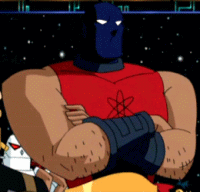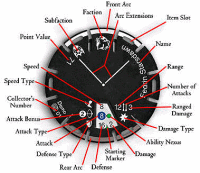Page: 1 2 3 4 5 6 7 8 9 
• Goto Comments
 The Le: I've usually given Wizkids the benefit of the doubts when it comes to production problems, but there's one thing that always bugged me though -- how did you guys miss the "Giant Symbol" on the DC GIANTS set?
The Le: I've usually given Wizkids the benefit of the doubts when it comes to production problems, but there's one thing that always bugged me though -- how did you guys miss the "Giant Symbol" on the DC GIANTS set?
Jason Mical: Well, to be fair, we should have implemented better quality control to catch the production problems. We might not have solved all of them but there were some that could have been avoided, like the Giant Symbol from DC Giants. If I remember correctly that may have been the time when one of the symbols somehow got swapped out between the final proofing phase and when the data went to the factory, or the factory didn't have the symbol, or something like that. To be honest I don't precisely remember. We took a good degree of flak for it and rightly so. Things like that are the things we should have caught.
The Le: Well I've always believed you guys took a lot of blame for things that might have been out of your control. What kinds of challenges did you face when dealing with the factories?
Jason Mical: Some of the things with the factory were beyond our control, yeah. We used several vendors in mainland China to produce our games. There were several challenges: sometimes there were incompatibilities with the software that delivered the dial information, which resulted in some dial misprints. The Chinese work-year cycle didn't help either. As anyone who has ever dealt with manufacturing in China can attest, Chinese New Year is difficult as most of the factory workers go home during this time (I should note, Chinese factories are almost small, self-contained towns where workers will come in from across the country to work for a season or two to earn money to take back home.) The factories shut down during Chinese New Year and worker turnover is really high, sometimes as high as 75% afterwards, so the new workers have to be trained. This is most noticeable to the end customer when it's substandard paint jobs or poorly-packed boxes.
There's also the delay in shipping from the factories, usually a month or more. We could airfreight things in and occasionally did for conventions but it's prohibitively expensive to do that for anything in large quantities. We did actually lose stock off a container ship a couple of times as well (this apparently happens more than you might think, which is a scary prospect for me as I'm about to pack my life into a container again for another international move). Luckily insurance covers that when it happens.
The Le: I've never played Mage Knight, but I am utterly fascinated with the Mage Knight 2.0 PIE DIAL -- I think it's far superior to the standard HeroClix dial. Can you give us any tidbits it about it, and why we've never seen it in HeroClix?
 Jason Mical: It's not a major secret that the original HeroClix rules and the powers and dial were pretty much straight out of Mage Knight. We actually debated whether rebooting HeroClix in the same way Mage Knight was rebooted with 2.0 would be a good thing or not. MK2.0 was such a large leap forward for the game that it left a lot of the original players in a real lurch, and there was sort of a feeling that doing the same thing to HeroClix would not be a good thing for the game. There was also a bit of a feeling of 'if it's not broke, don't fix it.'
Jason Mical: It's not a major secret that the original HeroClix rules and the powers and dial were pretty much straight out of Mage Knight. We actually debated whether rebooting HeroClix in the same way Mage Knight was rebooted with 2.0 would be a good thing or not. MK2.0 was such a large leap forward for the game that it left a lot of the original players in a real lurch, and there was sort of a feeling that doing the same thing to HeroClix would not be a good thing for the game. There was also a bit of a feeling of 'if it's not broke, don't fix it.'
The solution we finally hit on, adding the card mechanics and Seth's additional rules changes, I think reflected better the kind of game that HeroClix was and needed to be. Mage Knight was always more of a skirmish-level miniatures game, where HeroClix was - or at least had the potential to be - a somewhat simpler (feel free to argue that point) and more casual game. Part of that is a stigma associated with wargaming, that it's something that only appeals to hardcore gamers while HeroClix was always designed to appeal to a wider crowd, comic people who might want to dabble in strategy gaming.
So I guess the answer to the question is that we didn't want to overhaul the mechanics in the same way 2.0 overhauled Mage Knight. We focused instead on ways to keep old pieces worth playing while adding enough new things to make the game interesting. Seth's game design also helped this a lot; I can't say enough good things about his design prowess and ability to make pieces genuinely interesting to play. To be honest, Seth would be a good person to ask about this because he could get into far more depth than I can about it.
The Le: Okey, to Seth Johnson then -- same question.
SETH JOHNSON: The first products I designed at WizKids were Mage Knight expansions (Omens and Nexus), shortly after Mage Knight 2.0 had released. So like Jason, I'm definitely familiar with what fans and players were saying around that time.
When I moved over to work on HeroClix, we had a number of design meetings where we talked about where the game was, and where it needed to go. Unless a game is a standalone one-shot, it needs to grow and change, both to improve on the past and set a course into a exciting future. HeroClix is no exception. But the lesson we learned from MK 2.0 was that making a lot of changes all at once made some longtime players feel like we'd pulled the carpet out from underneath them--they enjoyed the game as it was and had invested a lot of money in it, and they (justifiably) didn't like anything that put that enjoyment or their investment at risk. So whenever we sat down to talk about potential changes we might make to Heroclix, it was always with an eye both on new players and the players who had been with the game since the beginning. We were always trying to improve the game's accessibility and breadth of game play, but hopefully never leading our existing players to regret the money they'd spent on our products and how much they enjoyed the game.
I often see it argued on fan forums about whether the current state of the HeroClix rules is HeroClix 2.6 or HeroClix 1.17 or HeroClix 14.0. I like that there's no clear answer; it means that we made those needed transitions from one state of the HeroClix rule set to another as smooth as possible, and that on the whole players feel it's one large evolving continuum rather than a line with a big compatibility break in it. Compatibility breaks have their benefits--see what the 3.0 and 4.0 breaks have done for Dungeons & Dragons--but I really like that someone who took a leap and spent the money to buy into an unknown set called Infinity Challenge could still be bringing some of their first loves to the battlefield when Arkham Asylum was on the shelves. You might not _want_ to, but at least it's a choice the player made rather than one we forced upon them.
All of which is prelude to saying that we did talk about whether or not we wanted to change the HeroClix dial to one with a pie-shaped slot rather than an L-shaped slot, and whether or not to add a mechanic similar to the MK 2.0 nexus abilities to HeroClix. There were production-cost reasons in the mix, but from a design standpoint it was eventually decided that we wanted to maintain that enduring continuum of figures that looked and played alike, and not add the layer of confusion that would come with two powers appearing in one slot via a nexus. When we did eventually add that possibility via special powers, it was only after several more years of cleaning up the wording of powers and when we could include character cards that allowed us to include specialized rules text when needed to help clarify the combos for players.
Page: 1 2 3 4 5 6 7 8 9 